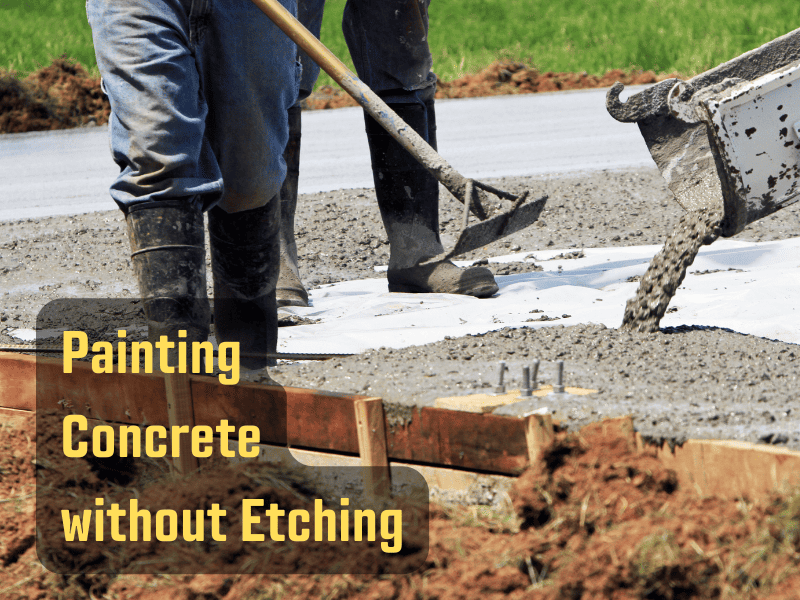When tasked with painting concrete, the traditional method involves etching—the application of mild acid to roughen the surface, thereby ensuring better paint adhesion. However, there may be instances where etching is not feasible or desirable. In such situations, understanding alternative methods is essential. This article provides a guide on how to paint concrete without etching, from understanding surface preparation to considering safety and equipment requirements.
Table of Contents
Understanding Concrete Surface Preparation
Before beginning any painting process, understanding why surface preparation is critical is paramount. Concrete is a naturally porous material. These microscopic pores can trap air, moisture, and dirt over time. When you apply paint over such a surface, these trapped elements can interfere with the paint’s ability to adhere properly, leading to an uneven application and reduced longevity of the paint job.
Concrete can often have a smooth, dense surface profile, especially if it has been power troweled. Paint doesn’t adhere well to smooth, dense surfaces, which is another reason surface preparation is necessary before painting. However, it’s worth noting that while etching is a widely used method of surface preparation, it isn’t the only option available.
The Alternatives to Etching
There are alternatives to etching, each with its pros and cons. It’s important to consider the specific requirements of your project when choosing the appropriate method.
Grinding
Grinding is a mechanical process using abrasive discs to smooth and open the concrete surface. This method is particularly effective for interior concrete surfaces where you may not want to use acid etching due to ventilation issues. Grinding offers a number of benefits. Firstly, it’s an efficient method for removing old paint, sealers, and some forms of concrete damage like spalling. Secondly, the process opens up the pores of the concrete, enabling the paint to adhere more effectively. However, grinding requires specific machinery and may produce a substantial amount of dust, necessitating proper safety equipment and potentially professional assistance.
Shot Blasting
Shot blasting is another mechanical method that can effectively prepare a concrete surface for painting. This technique involves a machine that propels steel shots at high speed against the concrete surface, much like sandblasting. The steel shots effectively abrade the surface, removing contaminants and providing a roughened surface profile for the paint to adhere to. While this method is highly effective, it requires specialized equipment and safety considerations, making it more suitable for larger or commercial projects.
The Painting Process Without Etching
Painting concrete without etching involves five key steps, each of which requires careful attention to detail.
Step 1: Cleaning
Irrespective of your chosen preparation method, you must begin by thoroughly cleaning the concrete surface. This can be done using a pressure washer to remove loose dirt, dust, grease, or grime. Consider using a commercial concrete cleaner and a stiff-bristle brush to scrub the surface for stubborn stains or deeply ingrained dirt. Allow the surface to dry completely before proceeding to the next step.
Step 2: Surface Preparation
Following cleaning, your chosen method of surface preparation—grinding or shot blasting—comes into play. This process requires specific safety equipment, such as goggles, dust masks, and possibly ear protection, depending on the noise level of the equipment used.
Step 3: Primer Application
Once the concrete surface is adequately prepared, it’s time to apply a concrete bonding primer. The primer penetrates the concrete surface and provides a more adhesive surface for the paint. This, in turn, increases the durability and longevity of the paint job. Remember to follow the manufacturer’s instructions when it comes to drying times for the primer.
Step 4: Painting
Once the primer is dry, it’s time to apply the paint. Depending on your concrete surface’s size and preference, you may use a paint sprayer, roller, or brush. The important thing to remember here is to apply thin, even layers of paint, allowing each layer to dry before applying the next. This approach will result in a more uniform finish and increase the paint job’s durability.
Step 5: Sealing
After the paint has dried completely, consider applying a sealer. While not mandatory, this additional step is highly recommended as it provides an extra layer of protection against weathering, wear and tear, and ultraviolet radiation.
Considerations when Painting Concrete Without Etching
Painting concrete without etching is certainly achievable and can yield excellent results. However, it’s important to consider the following points before you begin.
Safety
The use of mechanical equipment, such as concrete grinders or shot blasters, can be hazardous if used improperly. Ensure you understand the operation of these machines and are equipped with the necessary safety gear—dust masks, safety goggles, and protective clothing.
Equipment
As mentioned earlier, shot blasting and grinding require specific equipment. While these machines can often be rented from home improvement stores, they can also be expensive and might require some expertise to use correctly.
Professional Help
Given the complexity, potential risks, and equipment involved in painting concrete without etching, sometimes it might be more efficient and safer to hire professionals. Not only do they have the skills and experience to deliver high-quality results, but they also have access to professional-grade equipment and materials that may be beyond the reach of most DIY enthusiasts.
Conclusion
The process of painting concrete without etching is not just possible; it provides an excellent alternative when etching is not practical or desirable. You can achieve durable and visually appealing results by understanding the principles of surface preparation and paint application. Remember that careful preparation and proper application are the keys to a successful paint job. Happy painting!
